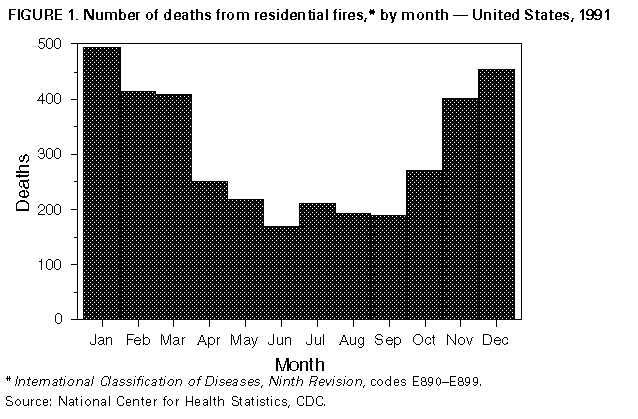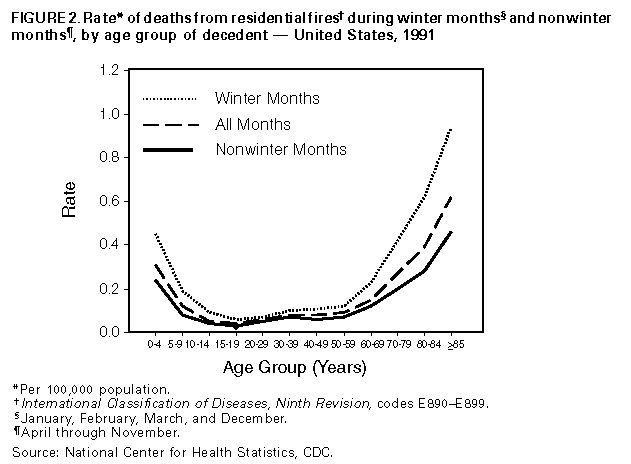 |
|
|
|
|
|
|
|
|
|
|
|
|
|
|
|
|
||||
| ||||||||||
|
|
|
|
Health Objectives for the Nation Deaths Resulting from Residential Fires -- United States, 1991Most residential fires occur during December through March -- a period of colder weather and longer darkness. During 1991, residential fires were the second leading cause of injury deaths (after motor-vehicle-related injuries) among children aged 1-9 years (1) and the sixth leading cause of such deaths among persons aged greater than or equal to 65 years. Because of seasonal variations in the occurrence of residential fires, CDC analyzed death certificate data from U.S. vital statistics mortality tapes maintained by CDC's National Center for Health Statistics and data from the National Fire Incidence Reporting System (NFIRS) to improve characterization of selected residential fires. This report summarizes the analysis of death certificate data for 1991 and data from NFIRS for 1990. Deaths from residential fires were identified using International Classification of Diseases, Ninth Revision, external cause of injury codes E890-E899 and place of occurrence noted as residence on the death certificate. Information about the causes of fire-associated deaths was obtained from NFIRS, maintained by the U.S. Fire Administration, which gathers detailed reports of a sample of fire-associated deaths collected from approximately 13,500 fire departments in 41 states (2). NFIRS estimates of deaths associated with residential fires for children aged less than 5 years were based on 279 deaths, and for adults aged greater than 70 years, 368 deaths. In 1991, residential fires accounted for 3683 deaths; of these, 1773 (48%) occurred during January (495), February (415), March (409), and December (454) Figure_1. These deaths included 711 (19%) among children aged less than 5 years and 898 (24%) among persons aged greater than or equal to 70 years. In comparison with the total population, the rate for fire-related death was highest for the young and the elderly Figure_2. Based on NFIRS data for January-December 1990, the causes of the fires were known for 522 (72%) deaths of children aged less than 5 years; the three leading causes were 1) children playing with fire-ignition sources (e.g., matches) (37%), 2) faulty or misused heating devices (19%), and 3) faulty or misused electrical distribution sources * (11%). For persons aged greater than 70 years, the causes of fires were known for 247 (67%) deaths; the three leading causes were 1) careless smoking (33%), 2) faulty or misused heating devices (19%), and 3) faulty or misused electrical distribution sources (12%) (2). Data from the 1990 NFIRS were used to estimate the numbers of fires and deaths associated with selected causes of residential fires during January, February, March, and December (2). During these months in 1990, residential electrical-distribution fires were associated with an estimated 40,000 fires and 266 deaths Table_1. Residential fires involving fireplaces and chimneys resulted in an estimated 26,200 fires, and portable kerosene and electrical heaters were involved in an estimated 1500 fires. Christmas tree fires caused approximately 600 residential fires and 29 deaths; the ratio of deaths to fires was 1:21. Reported by: Div of Unintentional Injury Prevention, National Center for Injury Prevention and Control, CDC. Editorial NoteEditorial Note: Despite the 37% decline in rates of residential-fire deaths from 1970 through 1991 (1), the overall rate in 1991 (1.5 per 100,000) exceeded the rate targeted by a national health objective for the year 2000 (reducing the rate of residential fire-related deaths to no more than 1.2 deaths per 100,000 persons {objective 9.6}). In particular, the rates for children aged less than 5 years (3.7 per 100,000 children) and for persons aged greater than or equal to 65 years (3.5 per 100,000) -- the highest-risk groups -- exceeded the age-group-specific target goal of 3.3 per 100,000 for each group (1,3). The increased occurrence of fire-related deaths during winter months reflects the seasonal use of portable heaters, fireplaces and chimneys, and Christmas trees (2). Fires associated with electric portable heaters usually result from electrical shortages or device failure, rather than from ignition of nearby materials such as draperies. Electric cords for portable electric space heaters should be plugged directly into the wall and not linked through an extension cord, kept at least 3 feet from any combustible object, and unplugged when not in use. Fires attributed to the use of kerosene portable heaters usually result from using the wrong fuel, faulty switches and valves, and fuel leaks and spills that subsequently ignite. Kerosene heaters should be used only with K-1 kerosene, rather than gasoline or camp-stove fuel, and should be re-fueled outdoors after the heater has cooled. Chimney fires usually result from a build-up of creosote, a highly flammable by-product of wood fires. Chimneys should be cleaned or inspected annually to detect and prevent creosote build-up. A fire screen should be used in front of the fireplace; wood stoves and fireplaces should burn only seasoned wood -- not green wood, trash, or wrapping paper. Fires related to Christmas trees usually result from electrical problems (e.g., overloaded electrical circuits caused by using several extension cords in one outlet, or frayed wire and cords). In 1991, Christmas trees accounted for the lowest number of fires, but a substantially higher proportion of deaths than other types of residential fires described in this report Table_1. Persons in households with these holiday decorations should periodically examine the electric lights used and should not place trees near heating sources or fireplaces. In addition, live-cut trees should be sufficiently watered to reduce drying; dry trees ignite easily and burn rapidly. To reduce the risk for death or injury resulting from fires, a smoke detector should be installed outside each sleeping area on every habitable level of a home and the battery changed at least annually. Occupants should develop escape plans that include the identification of two exits from every living area and should practice exit drills and meeting at a designated place at a safe location sufficiently distant from the home. In addition, every home should have a multipurpose fire extinguisher ready for use in extinguishing small fires. Residences should be evacuated for any fire that cannot be extinguished within 1 minute because of the rapid rate of accumulation of heat and smoke; once evacuated, residences should not be reentered. Persons who become trapped in a residence should crawl on the floor toward an exit to avoid inhalation of smoke that has risen. Because children playing with fire-ignition sources were the leading cause of fires that resulted in the deaths of children aged less than 5 years, children should be taught not to play with matches or lighters. In addition, young children should be told to inform an adult immediately if they see a fire starting. Other precautions should include storing matches and lighters out of the reach of young children; wooden "strike anywhere" kitchen matches should not be used or kept in homes with young children. Programs directed at modifying the environment and behaviors may assist in reducing the number of deaths from residential fires. For example, CDC is working with the Maryland Department of Health and Mental Hygiene, Division of Injury and Disability Prevention and Rehabilitation, to install smoke detectors in homes, implement a public health education campaign about smoke detector use and maintenance, and pass and enforce local smoke detector ordinances. References
* Includes wiring, transformers, meter boxes, power switching gear, outlets, cords, plugs, and lighting fixtures as sources of heat. Figure_1  Return to top. Figure_2  Return to top. Table_1 Note: To print large tables and graphs users may have to change their printer settings to landscape and use a small font size.
TABLE 1. Estimated number of residential fires, number of deaths, and ratio
of deaths to fires, by selected causes -- United States, 1990
=============================================================================
No. Estimated Ratio
Cause deaths no. fires (deaths:fires)
-----------------------------------------------------------------------------
Christmas trees 29 600 1:20
Portable heaters 56 1,500 1:27
Electrical distribution * 266 40,000 1:150
Fireplaces and chimneys 58 26,200 1:452
-----------------------------------------------------------------------------
* Includes wiring, transformers, meter boxes, power switching gear, outlets,
cords, plugs, and lighting fixtures as sources of heat.
Source: National Fire Incidence Reporting System, U.S. Fire Administration.
=============================================================================
Return to top. Disclaimer All MMWR HTML versions of articles are electronic conversions from ASCII text into HTML. This conversion may have resulted in character translation or format errors in the HTML version. Users should not rely on this HTML document, but are referred to the electronic PDF version and/or the original MMWR paper copy for the official text, figures, and tables. An original paper copy of this issue can be obtained from the Superintendent of Documents, U.S. Government Printing Office (GPO), Washington, DC 20402-9371; telephone: (202) 512-1800. Contact GPO for current prices. **Questions or messages regarding errors in formatting should be addressed to mmwrq@cdc.gov.Page converted: 09/19/98 |
|||||||||
This page last reviewed 5/2/01
|